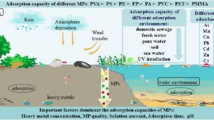Abstract
This paper examines the surface sediments collected from Dongping Lake in China for speciation and distribution of toxic heavy metals (Cu, Pb, Ni, Cd) in different grain size fractions, and for the factors that need to be considered in potential hazard of metals to the environment. Four grain size fractions (<63, 63–78, 78–163 and 163–280 μm), divided in wet condition, and bulk samples less than 280 μm in diameter were analyzed for their distribution, density and appearance. A three-stage extraction procedure following the BCR protocol was used to chemically fractionate metals into “acid soluble”, “reducible”, “oxidizable” and “residual” fractions. Correlation analysis was used to analyze the datasets. The results showed that <63 μm grain size part constitutes the major proportion of the sediments, but its density is the smallest among the four grain size fractions. In general, the metal content curve against grain size presents “S” distribution, and the highest concentrations do not exist in <63 μm grain size. Appearance observation indicates that the adsorbed substance increases gradually along with the decreasing grain size. The dominant speciation of elements and the extent of pollution are responsible for the metal distribution in different grain size sediments. While studying bioavailability and mobilization of metals, it is advisable to take metal speciation, grain size distribution and density into consideration.




Similar content being viewed by others
References
Bähr T, Fietz J, Henning KH et al. (1995) Mineralogie und geochemie von sedimenten und schwebstoffen der saale in Beziehung zu ihren Herkunftsgebieten unter Berücksichtigung anthropogener Einglüsse. Zbl Geol Paläont Teil I, (1/2):21–32
Campbell PGC, Tessier A (1987) Metals speciation, separation and recovery. Lewis Michigan, pp 201–224
Davidson CM, Thomas RP, McVey SE et al (1994) Evaluation of a sequential extraction procedure for the speciation of heavy metals in sediments. Anal Chim Acta 291:277–286
Ergin M, Kazan B, Ediger V (1996) Source and depositional controls on heavy metal distribution in marine sediments of the Gulf of Iskenderun, Eastern Mediterranean. Mar Geol 133(3–4):223–239
Fang TH, Hong E (1999) Mechanisms influencing the spatial distribution of trace metals in surficial sediments off the south-western Taiwan. Mar Pollut Bullet 38(11):1026–1037
Förstner U, Wittmann GTW (1983) Metal pollution in the aquatic environment. Springer, Berlin Heidelberg New York pp 481
Loring DM (1990) Lithium-a new approach for granulometric normalization of trace metal data. Mar Chem 29:155–168
Martincic D, Kwokal Z, Branica M (1990) Distribution of zinc, lead, cadmium and copper between different size fractions of sediments I. The Limski Kanal (North Adriatic Sea). Sci Total Environ 95:201–215
Milligan TG, Loring DH (1998) The effect of flocculation on the size distributions of bottom sediment in coastal inlets: implications for contaminant transport. Oceanogr Lit Rev 45(2):255–256
Salomons W, Förstner U (1984) Metals in hydrocycle. Springer, Berlin Heidelberg New York, pp 349
Singh AK, Hasnain SI, Banerjee DK (1999) Grain size geochemical partitioning of heavy metals in sediments of the Damodar River-a tributary of the lower Ganga, India. Environ Geo 39(1):90–98
Šurija B, Branica M (1995) Distribution of Cd, Pb, Cu and Zn in carbonate sediments from the Krka river estuary obtained by sequential extraction. Sci Total Environ 170(1–2):101–118
Szava-Kovats, Robert C (2002) Outlier-resistant errors-in-variables regression: anomaly recognition and grain-size correction in stream sediments. Appl Geochem 17(8):1149–1157
Tessier A, Campbell PGC, Bisson M (1982) Particulate trace metal speciation in stream sediments and relationships with grain size: implications for geochemical exploration. J Geochem Explor 16:77–104
Ujević I, Odžak N, Barić A (2000) Trace metal accumulation in different grain size fractions of the sediments from a semi-enclosed bay heavily contaminated by urban and industrial wastewaters. Water Res 34(11):3055–3061
Wang FY, Chen JS (2000) Relation of sediment characteristics to trace metal concentrations: a statistical study. Water Res 34(2):694–698
Author information
Authors and Affiliations
Corresponding author
Rights and permissions
About this article
Cite this article
Zhu, Y., Zou, X., Feng, S. et al. The effect of grain size on the Cu, Pb, Ni, Cd speciation and distribution in sediments: a case study of Dongping Lake, China. Environ Geol 50, 753–759 (2006). https://doi.org/10.1007/s00254-006-0247-8
Received:
Accepted:
Published:
Issue Date:
DOI: https://doi.org/10.1007/s00254-006-0247-8




